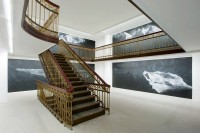TACITA DEAN
Fatigues-Fatigues
source: designboom
UK artist tacita dean has created ‘fatigues’, a six panel blackboard pieces recreating the mountainous landscape of afghanistan for dOCUMENTA in kassel, germany. following dean’s visit to kabul to film the rugged countryside belonging to this middle eastern nation, she found her footage to be flawed and instead offers this ex-business center enormous blackboard mural sketches picturing afghanistan’s terrain.
while some of the landscapes are covered in a bright white chalk, standing in stark contrast to the darkness of dean’s blackboard canvas, others are decorated with only a hint of line to portray the movement of rivers, snow and the interaction of these elements with sunlight.
the massive artwork spans the walls of an open air two-story space belonging to a former banking hall and was commissioned and co-produced by the festival for which the piece is displayed.
.
.
.
.
.
.
.
source: fastcodesign
The Hindu Kush mountains divide Afghanistan and make up a section of the Himalayas. They’re some of the most beautiful and historic landscapes in the world. For example, Kabul sits in the foothills of the Safed Koh range, home to the famous Khyber Pass–the same route to Pakistan used by invaders from Genghis Khan to Alexander the Great. Today, though, most people associate the region with the brutal fighting it has seen during the US tenure in Afghanistan.
British artist and filmmaker Tacita Dean wanted to include footage of the storied mountains in a new film, so earlier this year she commissioned a cameraman in Kabul to visit the region and collect video. Though it’s photogenic land, Dean apparently wasn’t happy about the footage. She abandoned her film and turned to a medium that couldn’t be more different from live motion: chalk and blackboard.
Relief is a series of chalkboard murals that Dean pulled from her discarded Afghanistan footage. The drawings depict the craggy landscapes in extreme wide angle, spanning entire walls of the gallery. Handwritten notes in the artist’s scribble read “narrative direction” and other filmmaking terms, as if the huge murals were ripped from an early storyboard for the abandoned project.
The series opened last week as part of the German art fair dOCUMENTA (13), which is taking place in the small town of Kassel until August. The drawings are installed in a decommissioned bank on a back street of the town, which anchors Relief in the 19th century. Though the interior of the building has been turned into generic gallery spaces, the intricate brass stairs and balustrade have been left alone. It’s a brilliant move on the part of dOCUMENTA’s curators, combining dignified architectural details and expansive, dusty, hand-drawn wilderness.


